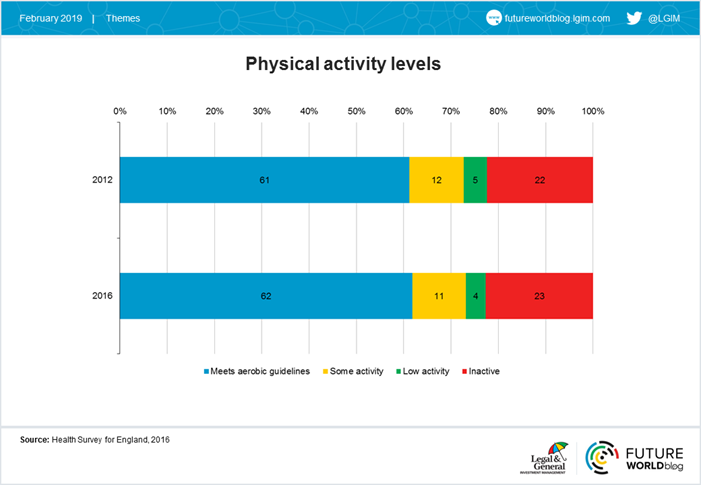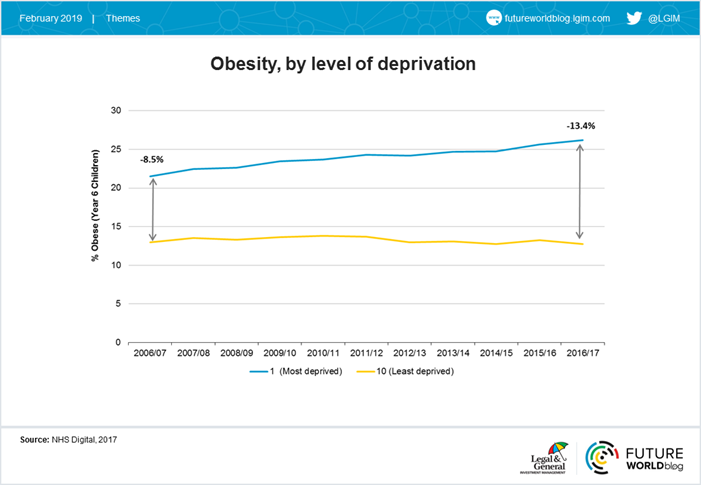Disclaimer: Views in this blog do not promote, and are not directly connected to any L&G product or service. Views are from a range of L&G investment professionals, may be specific to an author’s particular investment region or desk, and do not necessarily reflect the views of L&G. For investment professionals only.
Working out the UK's obesity crisis
Despite the high prevalence of obesity in the UK, the value of Britain’s gym market continues to grow. As these trends show no sign of abating, can the real estate sector put greater emphasis on wellbeing in retail and leisure to help get local communities more active?

In 2017, NHS Digital reported that 29% of UK adults were classed as obese, whilst 34% of children were categorised as overweight or obese by the time they left primary school, up from 15% in 1990.[1] The consequence of this trend for healthcare services is stark; obesity has a strong causal correlation with conditions such as heart disease and diabetes, and treating these puts immense strain on NHS budgets. This presents a bleak picture on both a societal and economic level, one that may prompt us to persevere with our New Year’s resolutions beyond January.
There are two underlying lifestyle trends that can be attributed to the acceleration of these issues. Firstly, our day-to-day lifestyles are becoming increasingly unhealthy. A growing proportion of the UK workforce is employed in more sedentary, office-based roles where, in short, we eat too much and fail to do enough exercise. Secondly, whilst there is a segment of the population that spends a greater proportion of their time and disposable income on their wellbeing – as demonstrated by the number of UK adults with a gym membership growing by 29% between 2013 and 2018[2] – overall levels of physical activity have failed to improve.
This suggests that there has been little progress in getting historically inactive individuals engaged with physical activity. Further to this, there is an increasing body of evidence that suggests that physical inactivity and obesity growth is becoming more pronounced within deprived demographic groups.
The impact on commercial property owners
These lifestyle trends have important implications for commercial property owners. Delivering a broad suite of health and wellbeing services through commercial property is a prime example of how an asset can deliver social value. Providing affordable fitness and educational facilities in locations where consumers are already living, working and shopping can help engage the local community in meaningful ways.
The value of the UK’s wellness market is estimated to reach £12.4 billion by 2020,[3] presenting opportunities for a breadth of services that can be incorporated into retail and leisure assets to engage local communities. This can include gyms, social fitness providers, athleisure retailers or health-orientated food and beverage operators.
This is mutually beneficial for owners and occupiers; gym operators, for example, benefit from access to prominent locations, with high footfall levels and good car parking. Similarly for owners, the long leases, strong covenants and frequent visits provided by gym operators are attractive and can help to curate multi-purpose retail and leisure destinations that drive footfall across different day parts.
There is no quick fix for UK’s obesity crisis. Behaviours relating to both diet and physical activity are time-consuming to change. However, offering a broader suite of wellness services within retail and leisure assets can help to engage and educate local communities on their health and wellbeing, whilst also providing commercial value to occupiers and owners.
[1] NHS Digital: Statistics on Obesity, Physical Activity and Diet, 2018. Adult obesity is classed as a BMI over 30kg/m²; childhood obesity is compared to a benchmark of children’s height and weight in 1990; the top 15% are classed as overweight, and the top 5% as obese.
[2] Allegra Strategies, 2018
[3] Global Data, 2018
Recommended content for you
Learn more about our business
We are one of the world's largest asset managers, with capabilities across asset classes to meet our clients' objectives and a longstanding commitment to responsible investing.



